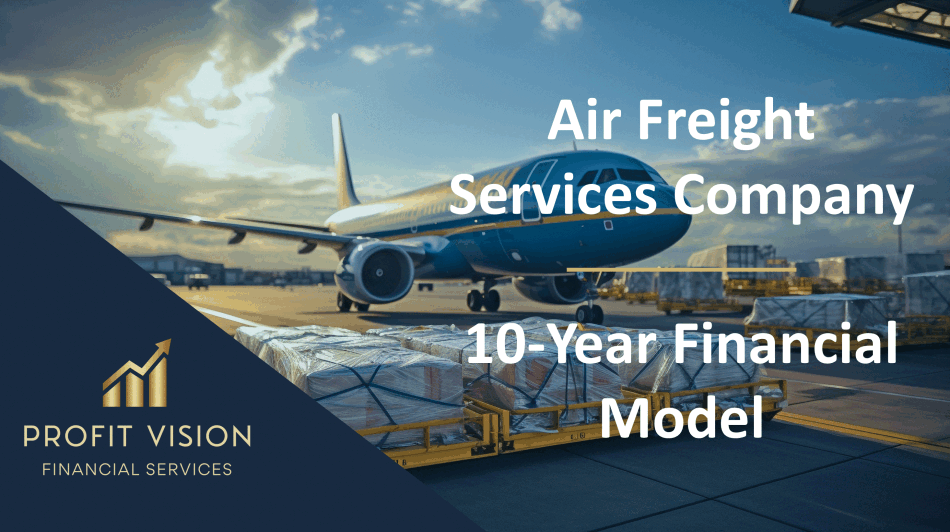Air Freight Services – 10 Year Financial Model (Excel XLSX)
Excel (XLSX)
BENEFITS OF THIS EXCEL DOCUMENT
- Provides a solid financial framework to evaluate performance, optimize operations, and guide strategic growth
LOGISTICS EXCEL DESCRIPTION
An Air Freight Services Company specializes in transporting goods and cargo by air, offering fast, reliable logistics solutions for domestic and international shipments. It manages freight handling, customs clearance, warehousing, and delivery coordination to ensure efficient supply chain operations. These companies serve industries that require speed and precision, such as manufacturing, healthcare, and e-commerce. By leveraging global airline networks, they help businesses move products quickly across borders while maintaining safety and compliance standards.
This 10-Year Air Freight Services Financial Model, is a comprehensive tool supporting long-term forecasting, profitability analysis, and investment planning. The model covers fleet operations, fuel costs, cargo volumes, pricing, and maintenance expenses, providing a solid financial framework to evaluate performance, optimize operations, and guide strategic growth.
The model includes calculations and assumptions for total fleet (5 different aircraft types) with planes either purchased or leased, Flights assumptions per aircraft type (maximum payload, flights per day), Revenue from Rentals and Ancillary Revenue Sources (Bulk Cargo, Express Courier Cargo), Direct Costs (fuels, maintenance, insurance, airport fees, commissions etc.), Payroll, Operating Expenses, Fixed Assets & Depreciation, Financing through Debt & Equity, Valuation and Exit multiple assumptions in case of a potential sale of the business.
The structure of the template follows Financial Modeling Best Practices principles and is fully customizable.
Model Structure
Inputs & Model Calculations:
• General Setup Assumptions, incl. Starting Expenses, Starting Fleet (purchased and leased), Freight Services assumptions, Sources of Revenue & Direct Costs, Financing (Debt & Equity) and Valuation Metrics
• Payroll, OpEx, and Capex, incl. Depreciation Schedule
• Forecast Scenarios including purchases and leases of new Jets
• Monthly Budget Allocation
Outputs:
• Monthly Cash Flow Budget & Budget vs Actual Variance Analysis
• Annual Financial Statements (3 Statement model – 10 Year Forecast)
• Break-Even Analysis
• KPIs & Financial Ratios, including several Profitability, Efficiency, Liquidity, and Leverage (Solvency) Ratios
• Performance Dashboard
• Business Valuation, including DCF Model, Return Metrics (NPV, EV, IRR, MOIC, ROI, etc.), and Sensitivity Analysis
• Investors Distribution Waterfall Model
• Dynamic Executive Summary with an option to choose the Exit Year and Exit Scenario (with or without Terminal Value)
Detailed instructions on the use of the model are included in the Excel file.
Help & Support
Committed to high quality and customer satisfaction, all our templates follow best-practice financial modeling principles and are thoughtfully and carefully designed, keeping the user's needs and comfort in mind.
Whether you have no experience or are well-versed in finance, accounting, and the use of Microsoft Excel, our professional financial models are the right tools to boost your business operations!
If you experience any difficulty while using this template and cannot find the appropriate guidance in the provided instructions, please feel free to contact us for assistance.
If you need a template customized for your business requirements, please e-mail us and explain your specific needs briefly.
Got a question about the product? Email us at support@flevy.com or ask the author directly by using the "Ask the Author a Question" form. If you cannot view the preview above this document description, go here to view the large preview instead.
Source: Best Practices in Logistics, Integrated Financial Model Excel: Air Freight Services – 10 Year Financial Model Excel (XLSX) Spreadsheet, Profit Vision









